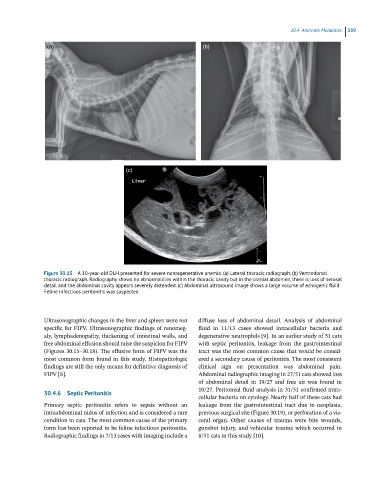Page 527 - Feline diagnostic imaging
P. 527
30.4 Alternate Modalities 539
(a) (b)
(c)
Figure 30.15 A 10-year-old DLH presented for severe nonregenerative anemia. (a) Lateral thoracic radiograph. (b) Ventrodorsal
thoracic radiograph. Radiography shows no abnormalities within the thoracic cavity but in the cranial abdomen, there is loss of serosal
detail and the abdominal cavity appears severely distended. (c) Abdominal ultrasound image shows a large volume of echogenic fluid.
Feline infectious peritonitis was suspected.
Ultrasonographic changes in the liver and spleen were not diffuse loss of abdominal detail. Analysis of abdominal
specific for FIPV. Ultrasonographic findings of renomeg- fluid in 11/13 cases showed intracellular bacteria and
aly, lymphadenopathy, thickening of intestinal walls, and degenerative neutrophils [9]. In an earlier study of 51 cats
free abdominal effusion should raise the suspicion for FIPV with septic peritonitis, leakage from the gastrointestinal
(Figures 30.15–30.18). The effusive form of FIPV was the tract was the most common cause that would be consid-
most common form found in this study. Histopathologic ered a secondary cause of peritonitis. The most consistent
findings are still the only means for definitive diagnosis of clinical sign on presentation was abdominal pain.
FIPV [8]. Abdominal radiographic imaging in 27/51 cats showed loss
of abdominal detail in 19/27 and free air was found in
10/27. Peritoneal fluid analysis in 31/51 confirmed intra-
30.4.6 Septic Peritonitis
cellular bacteria on cytology. Nearly half of these cats had
Primary septic peritonitis refers to sepsis without an leakage from the gastrointestinal tract due to neoplasia,
intraabdominal nidus of infection and is considered a rare previous surgical site (Figure 30.19), or perforation of a vis-
condition in cats. The most common cause of the primary ceral organ. Other causes of trauma were bite wounds,
form has been reported to be feline infectious peritonitis. gunshot injury, and vehicular trauma which occurred in
Radiographic findings in 7/13 cases with imaging include a 8/51 cats in this study [10].

